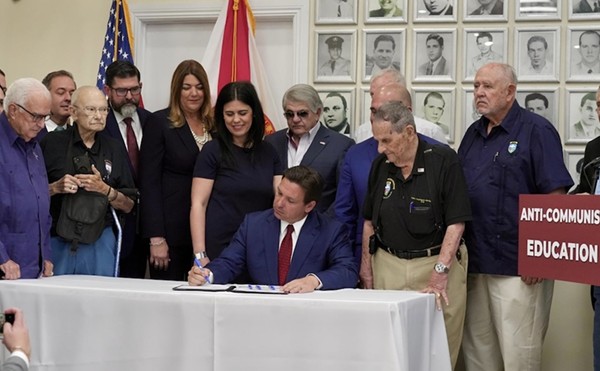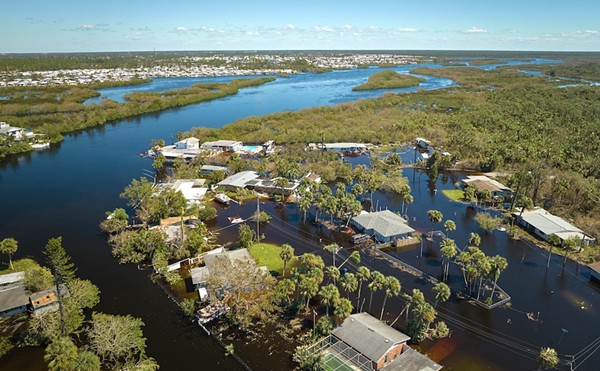Orlando Weekly last visited Ann Gilvin four years ago, a few months after bulldozers began clearing a path for a perimeter fence around a 727-acre parcel inside Oviedo's city limits that borders the Seminole County property on which she lives. That parcel, owned by Tampa-based Richland Properties and called River Oaks, was slated for a massive overhaul: No longer would it contain forest and wetlands; no, it was being developed for tract housing. Four years later, that project is well on its way.
That alone upsets Gilvin. But even worse, she fears the development will kill the hundreds of gopher tortoises that live on and around that land. Even more, she says, it will wreak considerable havoc on the scores of species who make their home deep inside or near the tortoises' 15-foot-long underground burrows.
From the Florida Game and Fresh Water Fish Commission's perspective, however, the tortoise is the one to watch. Other critters can relocate when the bulldozers come in; the tortoise can't. In fact, gopher tortoises spend most of their 40- to 60-year lifespan in the same two or three acres of usually upland, sandy terrain.
Unfortunately, developers also like sandy, upland areas. And because the tortoises have considerably less political clout than their bulldozing counterparts, their numbers are decreasing -- so much so, in fact, that they are now considered a "species of special concern" in Florida. That basically ranks them in the third tier of environmental protection: Individual gophers are protected, but their habitats aren't.
In theory, developers have to take many precautions before building over a gopher habitat. First, they must hire an environmental consultant to survey and approximate the number of tortoises on the property, then pay either to have the tortoises relocated to a safe ranch or pay a hefty fee -- roughly $4,000 and $6,000 for each habitable acre -- to bulldoze over the burrows (killing the tortoises) with what's called an incidental take permit.
In practice, however, some say the system doesn't work as it was intended. They say a complete lack of accountability -- Game and Fish officials admit that, when it comes to gopher relocations, developers are basically put on the honor system -- undermines the law's effectiveness and could allow someone to run roughshod over the tortoises.
From a financial standpoint, the fewer number of gophers tortoises found in the survey, the less cash the developer is required to shell out to remedy the situation. And if a developer did choose to bulldoze a gopher habitat without first securing an incidental-take permit, Game and Fish officials say that finding enough evidence to prosecute him would be damn near impossible.
So they're left trusting the developers to do the right thing. "We go on what their consultants tell us," says the game commission's Tim Breen. "We trust them all the same."
Gilvin has a hard time with that. "There's just something wrong," she says. "They assume everyone is on the up-and-up."
In the four years since that bulldozer first appeared, she's collected a closet-full of information on River Oaks and its primary players and written letters to the Game and Fresh Water Fish Commission, as well as elected officials all over the state. She even made a nine-minute homemade videotape for the Oviedo City Council that documented the many different, rare and sometimes threatened creatures that inhabit Richland's acreage.
In short, she suspects Richland and the environmental consultant firm it hired -- Clermont-based Modica and Associates -- not only undercounted the number of gopher tortoises on the property but also failed to properly relocate those that they removed. Moreover, she's miffed that the River Oaks project is ongoing, despite her complaints to the game commission and the city of Oviedo.
At the heart of her complaint is an apparent disparity between the number of counted tortoises and the number actually removed.
In March 1999, Modica and Associates surveyed the River Oaks land, and reported its results for the 185-acre first phase of the development: 1.4 gophers per acre, or about 255 total. (That number is the product of a complicated formula: The surveyor observes the number of burrows on roughly 15 percent of the planned development, and extrapolates to estimate the total number. That number is then reduced by 40 percent, to account for abandoned burrows or dead tortoises. Almost everyone interviewed for this article agreed that it was a flawed and imperfect formula.)
Richland chose not to seek an incidental-take permit, which easily would have cost more than $1 million. That meant it had to safely capture and relocate the tortoises it found to an appropriate habitat -- in this case, a ranch that Modica and Associates president Jim Modica co-owns in Lake County.
But Modica relocated only 19 gophers -- just 7.5 percent of what was expected.
Gilvin raised hell, accusing Modica of all sorts of misconduct. She suspects Richland of using Modica to save a few bucks.
"We call her the tortoise lady," says Modica, who is also vice chairman of the Lake County Water Authority and former director of the Orlando office for the St. Johns River Water Management District. Indeed, Gilvin has made a nuisance of herself to the developer. But she does raise valid questions, questions that Modica addresses on two fronts.
First, he says, plans to develop the land changed. In other words, Richland chose to develop only a little more than 100 acres, instead of the original 185 acres in its Phase I construction. On that acreage, he says, there weren't as many gophers to be found. When the next phase that runs near Gilvin's back yard is surveyed, he expects the number to increase.
Second, Modica says, when he conducts surveys, he overestimates the number of tortoises to prevent any project delays. If, for example, he were to estimate 25 gophers and find 26, the project comes to a stop and the permits are re-examined. So to keep the project moving, he inflates his numbers.
Because Richland is relocating the tortoises from River Oaks to his own ranch, Modica adds, it would be financially beneficial for him to find as many tortoises as he can, given the $350-a-head fee he charges the developer. As it is, he says, his reputation and income as a consultant -- the firm grosses more than $1 million a year -- are not worth risking. "If you lie and you get caught, you've got a problem," he says. "I'm not going to lie. Not for some tortoises."
That's not enough to placate Gilvin. She called the game commission, which dispatched an enforcement officer to check on her claim that tortoises were being undercounted and harmed. She was told at the time, as Game and Fish officials still say today, that it's virtually impossible to prove wrongdoing in this or any similar situation, simply because the bulldozers trap the gophers in their burrows, where they eventually die underground. Meanwhile, slabs of concrete are being poured over any potential evidence.
Thus, it's easier to catch and prosecute someone who illegally traps one gopher in the back of his pickup than it is to prove a developer's potential wrongdoing. That's not to say there was wrongdoing in this instance. But the fact is, no one will never know.
"We have environmental consultants," says Doug Franke, who reviewed Modica's permit for the game commission, "which, in all respects, are supposed to be out there looking at the environment in a way that benefits [wildlife]." The only way around simply trusting those behind the bulldozers, he says, is for state agents to personally double-check each and every survey -- something that the Game and Fresh Water Fish Commission has neither the finances nor the manpower to do.
But, he adds, "I wish we could."



















